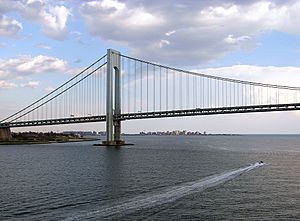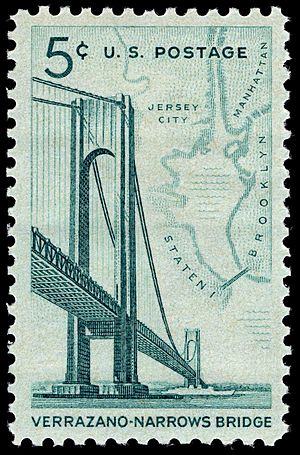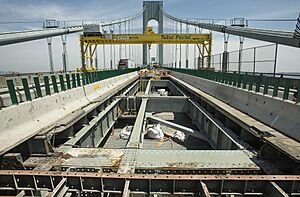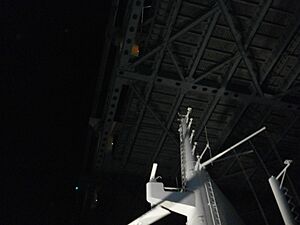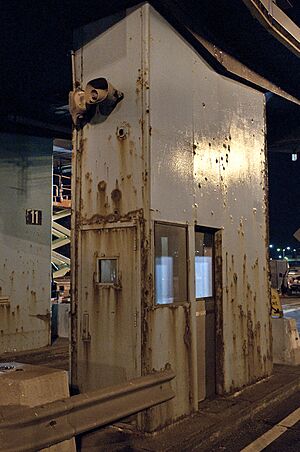Verrazzano-Narrows Bridge facts for kids
Quick facts for kids Verrazzano-Narrows Bridge |
|
|---|---|
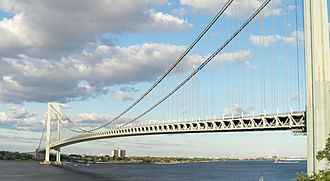 |
|
| Coordinates | 40°36′23″N 74°02′44″W / 40.60639°N 74.04556°W |
| Carries | 13 lanes of (7 lanes on upper level: 6 fixed-direction, 1 reversible HOV lane; 6 lanes on lower level) |
| Crosses | The Narrows |
| Locale | New York City (Staten Island–Brooklyn), New York |
| Other name(s) | Verrazano-Narrows Bridge Verrazzano Bridge Narrows Bridge |
| Maintained by | MTA Bridges and Tunnels |
| Characteristics | |
| Total length | 13,700 ft (4,176 m) |
| Width | 103 ft (31 m) |
| Height | 693 ft (211 m) |
| Longest span | 4,260 ft (1,298 m) |
| Clearance above | 15 ft (4.57 m) (upper level) 14.4 ft (4.39 m) (lower level) |
| Clearance below | 228 ft (69.5 m) at mean high water |
| History | |
| Designer | Othmar Ammann |
| Construction begin | August 13, 1959 |
| Opened | November 21, 1964 (upper level) June 28, 1969 (lower level) |
| Statistics | |
| Daily traffic | 202,523 (2016) |
| Toll | (Both directions) As of December 1, 2020[update]:
|
The Verrazzano-Narrows Bridge is a huge suspension bridge in New York City. It connects two of New York's areas, called boroughs: Staten Island and Brooklyn. The bridge stretches over a body of water known as the Narrows. This water links the Upper New York Bay to the Atlantic Ocean. It's the only way to cross the Narrows without a boat.
The bridge has two levels, carrying 13 lanes of Interstate 278. The top level has seven lanes, and the bottom level has six. The bridge is named after Giovanni da Verrazzano. He was the first European explorer to sail into New York Harbor and the Hudson River way back in 1524.
Building the bridge was a big project. Ideas for a bridge here started in the late 1920s. But it took many years for construction to begin in 1959. The famous engineer Othmar Ammann designed it. The top level opened on November 21, 1964. A second, lower level was added in June 1969 to help with all the cars. In 2014, a major upgrade project started for the bridge's two decks.
The Verrazzano-Narrows Bridge has a main span of 4,260 feet (1,298 meters). For a long time, it was the longest suspension bridge in the world. This changed in 1981 when the Humber Bridge in the United Kingdom became longer. Today, it's still the longest main span in the Americas. When the bridge was first named in 1960, its name was misspelled "Verrazano-Narrows Bridge" with one "z". This mistake was officially fixed in October 2018.
Building the Verrazzano-Narrows Bridge
Early Ideas for a Bridge
People started talking about building a bridge across the Narrows as early as 1926. At that time, Staten Island felt very separate from the rest of New York City. The main way to get there was by ferry. In 1928, a company suggested building a "Liberty Bridge" that would cost $60 million. This bridge would have tall towers, about 800 feet high.
The Liberty Bridge was planned to connect Bay Ridge, Brooklyn, to Staten Island. City planners hoped it would help Staten Island grow. But a politician named Fiorello La Guardia stopped the plan. He believed that big public projects should not be built by private companies.
Plans for Tunnels
Before the bridge, there were also plans for tunnels. In 1923, work began on a Staten Island Tunnel for subway trains, but it stopped two years later. There were also ideas for car tunnels under the Narrows. In 1929, the city set aside $5 million for these tunnels.
However, people in Bay Ridge did not want a bridge because it would mean tearing down homes. Work on the car tunnels started in 1930. These tunnels were supposed to connect Staten Island with Brooklyn. But in 1932, construction stopped because there wasn't enough money.
Why the Bridge Was Delayed
In 1933, the U.S. House of Representatives approved a bill for a suspension bridge. Famous engineer Othmar Ammann was interested in designing it. But in 1934, the War Department said no to the bridge. They worried that a bridge could block ships during a war.
So, people started thinking about a tunnel again. In 1936, New York City Mayor La Guardia asked for a bridge plan that would charge tolls. But he personally preferred a tunnel. Plans for a tunnel continued, and in 1943, money was set aside for a study. However, by 1945, Mayor La Guardia changed his mind and said it wasn't the right time for a tunnel.
Robert Moses's Bridge Plan
After the tunnel plans stopped, the idea for a bridge came back. In 1947, Robert Moses, a powerful city planner, announced that the city wanted to build a bridge. He believed a bridge would be cheaper than a tunnel. Moses and Mayor William O'Dwyer both supported the "Liberty Bridge" idea.
In 1949, the U.S. military approved the bridge plan. This happened even though many people in Bay Ridge were against it. They worried about their neighborhood and that the bridge might block the Narrows in a war. The bridge was designed to be high enough for large ships like the RMS Queen Mary to pass underneath.
The bridge was going to be expensive, costing about $200 million. Staten Islanders were careful about the project. They knew it would connect them to the city but also bring more traffic. Robert Moses thought the bridge was very important for Staten Island's future.
Getting Ready to Build
In 1955, New York Governor W. Averell Harriman signed a bill that allowed the Narrows Bridge to be built. It would be part of the new Interstate Highway System. Moses did not want subway tracks on the bridge, saying it would cost too much.
There was a lot of debate about where the bridge would connect in Brooklyn. Robert Moses wanted to extend the Gowanus Expressway through Bay Ridge. This would mean moving over 1,500 families. Many people in the community were very upset about this plan.
In 1958, the city approved the bridge plan. They also approved the controversial approach through Seventh Avenue in Brooklyn. This decision made many Bay Ridge residents angry because 7,500 people would lose their homes. However, Staten Islanders were generally happy because the bridge would connect them better to the rest of the city. This even caused real estate prices to go up on Staten Island.
In April 1959, the bridge was officially named after Giovanni da Verrazzano. But there was a small problem: the name was spelled with only one "z" instead of two.
How the Bridge Was Built
Work on the Verrazzano-Narrows Bridge officially started on August 14, 1959. A ceremony was held on the Staten Island side. The TBTA (Triborough Bridge and Tunnel Authority) was in charge of funding and building the bridge.
Othmar Ammann was the main engineer for the project. Many other engineers and workers helped build this massive structure. Before construction, old buildings were removed where the bridge's foundations would be. A 1,000-ton monument from World War I in Brooklyn had to be moved out of the way.
Building the Towers and Cables
Huge anchorages were built on both sides of the Narrows. These are massive concrete blocks that hold the bridge's cables. Each anchorage was 229 feet long and 129 feet wide.
Next, two large, watertight boxes called caissons were sunk into the water. The bridge's tall suspension towers would sit on top of these. The caissons were filled with concrete. This part of the work took over two years.
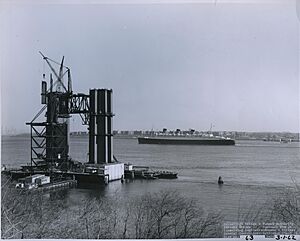
After the caissons were ready, the two suspension towers were built. Each tower is 693 feet tall. The Staten Island tower was finished by September 1962. Once the towers were up, workers started spinning the bridge's cables. This process began in March 1963 and took six months. Over 142,520 miles of wire were used to make the main cables!
In late 1963, the rectangular pieces for the roadway deck started arriving. These large pieces were floated to the bridge site by barge. The first piece of the deck was lifted into place in October 1963. By early 1964, the bridge was almost done.
The bridge was supposed to open in 1965, but construction went faster than expected. So, the opening was moved up to November 1964. About 1,200 workers were on the job every day for five years.
Sadly, three men died during the construction of the bridge. After the third death, workers went on strike. This led to safety nets being installed under the deck, which had not been there before. A writer named Gay Talese wrote a book about the bridge's construction called The Bridge: The Building of the Verrazano-Narrows Bridge.
Opening and Early Years
The upper deck of the Verrazzano-Narrows Bridge opened on November 21, 1964. The cost was $320 million. Over 5,000 people came to the opening ceremony, including many important officials. They cut a gold ribbon to mark the official opening. Cars were charged a 50-cent toll to cross.
The opening was a big celebration on Staten Island. A special postage stamp was even released to mark the event. The Metropolitan Transportation Authority (MTA) started a new bus route across the bridge. Five days after the bridge opened, the old ferry service between Staten Island and Bay Ridge stopped because it was no longer needed.
In the first two months, over 1.86 million vehicles used the bridge. This was more than expected! Other bridges and ferries saw fewer cars because people were using the new Verrazzano Bridge. By its first anniversary, 17 million drivers had crossed the bridge.
The Verrazzano Bridge was the last big project designed by engineer Othmar Ammann, who passed away in 1965. It was also the last major public works project in New York City led by Robert Moses.
Adding a Second Deck
Even though the bridge first opened with only one 6-lane roadway, it was designed to hold a second one. Engineers had added extra support beams to the bridge. This was a change made after the Tacoma Narrows Bridge collapsed in 1940.
The Verrazzano-Narrows Bridge became so popular that in March 1969, the TBTA decided to add the lower deck. This cost $22 million. The bridge was getting so much traffic that the second deck was needed much sooner than planned. The new six-lane lower deck opened on June 28, 1969.
Big Flags and Toll Changes
In 1976, for the United States' 200th birthday, a huge U.S. flag was placed on the bridge. It was described as being the size of "a football field and a half." But it ripped apart after only three days because of the wind. A new, even bigger flag was made in 1980. This one was placed on a steel frame to protect it from the wind.
In 1986, the TBTA stopped collecting tolls for cars going towards Brooklyn. Instead, they doubled the toll for cars going towards Staten Island. This was done to try and reduce traffic jams at the Staten Island toll booths. This one-way toll system lasted until 2020, when tolls were collected in both directions again.
In 2008, the bridge's "necklace lighting" (the lights on the cables) was updated. The old lights were replaced with new, energy-saving light-emitting diodes (LEDs).
Fixing the Name
The bridge's name was originally spelled "Verrazano" with one "z" due to a mistake in 1960. In 2016, a college student started a petition to fix the spelling to "Verrazzano" with two "z"s, like the explorer's actual name. Many politicians and Italian-American celebrities supported this.
In June 2018, the New York State Senate voted to change the spelling. The Assembly also passed the bill. On October 1, 2018, Governor Andrew Cuomo signed the bill into law. This officially changed the bridge's legal spelling to the "Verrazzano-Narrows Bridge." New road signs will have the correct spelling, while older signs will be updated over time.
Bridge Renovation
In 2014, a big $1.5 billion project started to rebuild parts of the bridge. The first part of this project cost $235 million and finished in 2017. It involved replacing the top deck sections. They also removed the divider on the upper deck and added a seventh lane. This new lane is a HOV lane, meaning it's for cars with multiple people.
The parts for the new deck had to be ordered from China. This is because the specific parts needed were no longer made in the United States. After the upper deck was replaced, parts of the lower deck will also be replaced.
The new HOV lane on the upper level opened on June 22, 2017. At the same time, the MTA removed the toll booths on the Staten Island side. This helps traffic move faster. There are also plans to add a path for bikes and walkers on the Verrazzano-Narrows Bridge in the future.
About the Verrazzano-Narrows Bridge
The Verrazzano-Narrows Bridge is owned by the Triborough Bridge and Tunnel Authority (TBTA). It's managed by MTA Bridges and Tunnels. The bridge is part of Interstate 278, which connects to the Staten Island Expressway and the Gowanus Expressway. The Verrazzano Bridge, along with other bridges, created a new way for people to drive from New Jersey to Brooklyn, Long Island, and Manhattan.
Each of the two tall suspension towers has millions of bolts and rivets. The towers contain a lot of metal, more than three times the amount used in the Empire State Building. Because the towers are so tall (693 feet) and far apart (4,260 feet), the curve of the Earth had to be considered when designing the bridge. The tops of the towers are actually slightly farther apart than their bases. When it was built, the bridge's towers were the tallest structures in New York City outside of Manhattan.
The four main suspension cables are each 36 inches thick. Each main cable is made of 26,108 wires, which would stretch for 142,520 miles if unraveled. The bridge has strong support beams under each roadway. These beams help the bridge stay stiff against wind and other forces.
When it opened, the Verrazzano-Narrows Bridge was the longest suspension bridge in the world. Its main span was 60 feet longer than the Golden Gate Bridge's. In 1981, the Humber Bridge in England became the new longest.
Because of how steel expands and shrinks with temperature, the height of the upper roadway can change. It can be about 12 feet lower in summer than in winter. The Narrows is the only way for large cruise ships and container ships to enter New York City. So, these ships must be built to fit under the bridge. The biggest ships, like the RMS Queen Mary 2, are designed with flatter funnels to have enough room.
Many birds, especially peregrine falcons, live on the bridge. These falcons are an endangered species. They nest at the very top of the Verrazzano-Narrows Bridge's towers. City workers put bands on the birds and check their nests every year to help protect them.
Bridge Usage
In 2015, about 202,523 vehicles used the Verrazzano-Narrows Bridge every day. It carries more traffic than the other bridges connecting Staten Island to New Jersey.
In 2011, a group said the Verrazzano-Narrows Bridge was New York's most dangerous. This was based on its age and how many people used it. But the MTA said the bridge was safe and in good condition. They said the group misunderstood the inspection reports.
Signs on the bridge tell people not to take photos or videos while on the bridge. These signs were put up after the September 11 attacks to increase security.
Public Transportation
Several bus routes use the Verrazzano-Narrows Bridge. Three local bus routes operated by MTA Regional Bus Operations cross the bridge. There are also 20 express bus routes that connect Staten Island with Manhattan.
Early plans for the bridge included subway tracks. However, Robert Moses, the city planner, said no to this idea. He said it would be too expensive. Some people believe he did this to encourage people to use cars instead of public transportation.
Walking and Biking on the Bridge
No Walkway or Bikeway
The Verrazzano-Narrows Bridge was not built with a path for walkers or bikers. It was thought to be too expensive at the time. The only times people can walk or bike on the bridge are during special events. These include the New York City Marathon and the Five Boro Bike Tour. The New York City Marathon has started at the Staten Island end of the bridge every year since 1976.
Ideas for a Path
People have asked for a walkway or bike lane on the bridge since it opened. In 1977, the city tried a temporary solution by modifying buses to carry bikes and passengers across the bridge. In 1993, the city planning department suggested adding a footpath.
In 1997, a study found that two footpaths on the upper level would cost at least $26.5 million. The MTA was worried about safety if people could walk or bike on the bridge.
In 2002, local residents started asking for a walkway or bikeway again. They pointed out that after the September 11 attacks, people had to walk home across the bridge's roadway. In 2011, a group called the Harbor Ring Committee started working to create a 50-mile path around New York Harbor, which would include a path on the Verrazzano.
In 2013, the MTA said they would study the idea of adding a path. In 2015, they looked into plans for a bike lane during the bridge's reconstruction. They estimated a dedicated path would cost $400 million. However, in March 2019, the plan was rejected due to safety concerns.
Tolls
As of December 1, 2020, tolls are collected in both directions on the Verrazzano-Narrows Bridge. If you pay by mail, it costs $9.50 per car. If you use E-ZPass from New York, it costs $6.12 per car.
Staten Island residents can get a special discount. If they register for the Staten Island Resident Rebate Program and use E-ZPass, they pay $2.75. There's also a special Carpool HOV E-ZPass for Staten Island residents. If three or more people are in the car, the toll is $1.70.
Before 2020, tolls were only collected when going towards Staten Island. This was because of a law passed in 1986. This one-way toll caused traffic problems in other parts of New York City. In 2019, a new law was passed to allow tolls to be collected in both directions again. This change happened on December 1, 2020.
Electronic Tolling
E-ZPass was first used at the Verrazzano-Narrows Bridge in 1995. This helped reduce traffic jams at the toll booths. In 1998, the MTA stopped selling toll tokens.
Even though tolls were only collected in one direction for many years, the unused toll booths stayed there. In 2010, some of the Brooklyn-bound toll booths were removed. By 2012, all of them were gone.
On July 8, 2017, cashless tolling began. This means there are no more toll booths where you can pay cash. Instead, cameras and E-ZPass readers are on overhead structures. If you don't have E-ZPass, a picture of your license plate is taken, and a bill is mailed to you.
Images for kids
-
Panorama of the bay with Fort Wadsworth (foreground) on the Narrows, under the Verrazzano-Narrows Bridge
See also
 In Spanish: Puente de Verrazano-Narrows para niños
In Spanish: Puente de Verrazano-Narrows para niños


